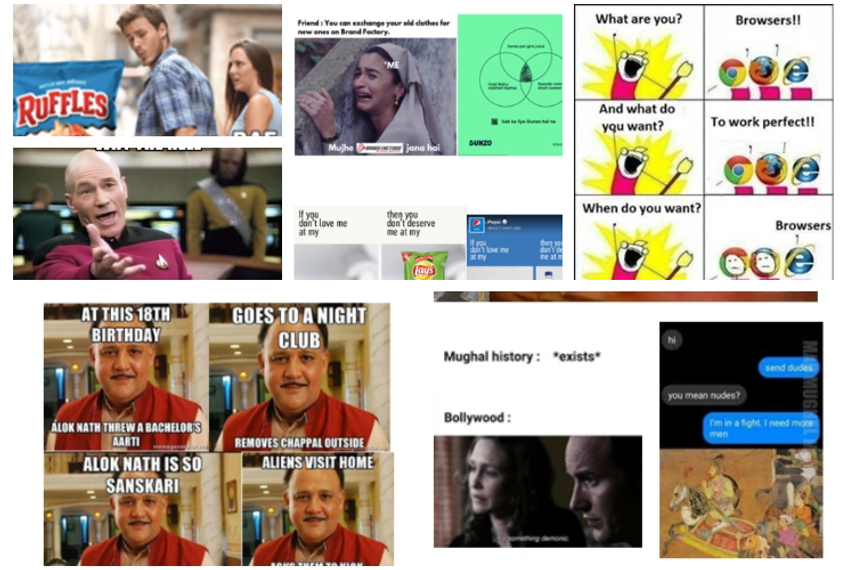In an attention starved world, memes grab attention. Memes were first popularised in the mid 90s, when short clips were shared between people in usenet forums. From its humble beginnings to celebrating full-fledged festivals (Meme Fest Delhi, 20181), memes have come a long way. They no longer sit in covert subforums and subreddits but are manifesting in the mainstream through group chats, television ads and even t-shirts.
They possess a now-ness that makes them popular and viral. We believe, there are deep drivers that have transformed memes into artifacts that capture history, culture and even traditions.
Memes reflect real-world emotions on a virtual platform - they are meta narratives that repurpose pop culture to serve ideas of contemporary urgency. While they still get used as comic devices, they’ve also become a recognised communication tool that spreads ideas, opinions and information.
One such example is the Alok Nath meme, which originated due to his hyperbolic demonstrations of Sanksriti (morality), and a tendency to suffer from heart attacks at the most inopportune moments. In a span of 3 days, the meme topped the Twitter chart and the rest, as they say, is history.
On the face of it, its popularity was attributed to its comic overtones, but upon further investigation, you can also sense an undercurrent of subversion. These memes take a stab at the idea of morality, which has now become a political tool. And, in an obscure way, the meme is a vehicle to rebel against a pressure to conform to nostalgic & idealised moral values in a reality where Gen Z is ‘woke’ and empowered.
The fact that memes are comic is a core quality that helps them replicate and serve as coded language that appeals to certain generational cohorts. There are clear in-and-out groups as a meme goes viral. Only those in the know have access and cultural fluency to grasp the meme’s hidden meaning, so Gen Z and Millennials get it, but Boomers don't. They are increasingly being called ‘the language of the cool’ since they serve as a medium through which the current generation communicates.
Memes are information providers and perception builders for all the conflicted souls that reside on the internet. They provide a raw, unfiltered, real and accurate description of our society in the most unique ways. The fact that memes polarise netizens adds to their subversive quality.
In fact, the administrator of the popular handle ‘Mad Mughal Memes’ has said that; ‘Over the years, our memes have become more topical and more relatable. With the rise of anti-Mughal narratives, our memes have developed a certain political angle as well. I’d say if the Mughals weren’t dragged into 21st century politics, we wouldn’t have responded with political memes in the first place.
Increasingly, memes are finding space in a new domain – advertising.
Arguably, one of the most critical roles of a brand is to locate itself in consumer culture and order to stand for values and philosophies that have a sense of present-ness.
Memes allow brands with plenty of opportunities to engage with their youthful audience. As such, memes are now being adopted by some brands as their core social media strategy. The use of memes leads to a belief that the brand has embedded itself deeply within youth culture.
An appropriate question to ask at this stage is - Do brands have the permission to use memes to their advantage? Are they truly participating in meme culture or are they merely appropriating it for their gain?
As discussed before, memes are not just visual devices but possess deeper meanings, and bearing this in mind, we must also investigate the extent to which brands appreciate the importance of their implicit meaning system.
And, if brands do wish to use memes within their marketing strategy then what are the parameters with which brands can authentically use memes, and bask in the halo of their subconscious benefits?
Parameter 1: Recency
Memes spread like wildfire. Like any wildfire, they create maximum impact while the fire is hot and not long after it is extinguished. Thus, it is extremely crucial for brands to up their meme game while a meme is trending.
Timely response makes the brand come across as modern, updated, cool and even smart. Sharing memes that were popular months or years ago lends the brand a frightening ‘Internet Explorer’ image.
Parameter 2: Humour and Subversion
Not all brands possess the tonality to use memes. Brands might be authoritative, scientific or even legacy minded. None of these qualities intuitively fit with the communication structure of memes.
In order to use memes, brands must possess the tone flexibility to communicate in a light hearted manner, rather than sounding serious or evangelising. Thereby, retaining the core quality of memes - making people laugh rather than forcing them into buying something.
In order to retain the core quality, brands should also not shy away from sharing humorous user generated content or even memes.
Parameter 3: Resonance
While everyone recognises the comic aspect of memes, memes also possess the potential to deliver on communication objectives.
Memes help build mental availability for brands, whilst leveraging visual codes that are memorable and impactful.
As such, the linkage between certain brands and their use of memes should be able to create some long term memory structures in the minds of consumers.
Thus, Brands might use memes not just as awareness tools but also as ways to reinforce favourable perceptions, which leads to preference.
Memes have become an extremely powerful communication tool that help in not just shaping, but also creating perceptions. While being comic is a core quality of memes, it is the ability to influence which shouldn’t be ignored. Brands can leverage this by sharing memes that are fresh, relevant and even hilarious. After all, memes allow brands to truly participate in a culture the consumers reside in.
The author is associate, Quantum.

